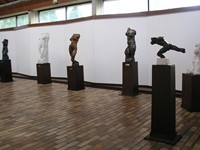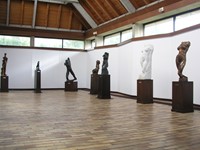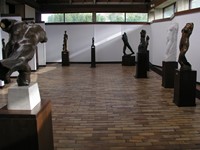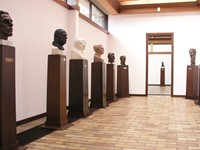Antun AugustinčIć Gallery is a SCULPTURE gallery because wherever we look we see some SHAPED VOLUME. Let us explore the volume of the sculptures regarding their SIZE, MATERIAL, DEGREE OF PLASTICITY, and ELEMENTS OF FORM (volume and space, plane, line, surface, colour), as well as their STYLISTIC FEATURES.
The SIZE of the sculptures in the Gallery ranges from SMALL SIZE SCULPTURES (sketches in Room III) to MONUMENTAL SCULPTURES (equestrian statue in Room III). They were all created or (in cases of figures cast in plaster of Paris) meant to be created in TRADITIONAL MATERIALS (stone, wood, and most often bronze), counting on the NATURAL COLOUR of the material.
They also differ in the DEGREE OF PLASTICITY. Some figures stand freely in space and we can fully appreciate them only if we move around them and view them from all sides. They are called SCULPTURES IN THE ROUND (for example the bronze Torso, 1941, in Room I). Some sculptures are only carved or modelled in the front and on the sides. They are called SCULPTURES IN RELIEF (for example the marble Torso, 1953, in Room I). Two Fighters in Room III can easily be recognized as a very HIGH RELIEF (because it appears to be separated from the surface) but there may be some doubt whether Abduction, 1928, in Room II is a LOW RELIEF (because the figure projects slightly from the background) or a HOLLOW RELIEF or INTAGLIO (because the surface of the background is the highest point of the relief on its edges). Many of Augustinčić’s reliefs are intended to stand freely in space, thus assuming the features of SCULPTURES IN THE ROUND.
ELEMENTS OF FORM also differ in various sculptures. Let us compare two examples.
The Harlequin, 1927, in Room I is an example of a dominant-passive relationship between VOLUME and SPACE. The subtle divergence of VOLUME is restrained by the rounded tension of PLANES and stirred to life by traces of modelling on the SURFACE. SPACE envelopes the volume rather passively, penetrating it only here and there thus resulting in a continuous undisturbed OUTLINE. With its stable VERTICAL COMPOSITION the sculpture gives an overall static impression.
Placed in the Gallery park Icarus, 1935, is an example of a dominant-active relationship between VOLUME and SPACE. The mass of limbs thinned into lines and the mass of wings flattened into planes diverge the VOLUME which then strongly penetrates the SPACE which, in turn, envelopes it actively. The volume and the space are further intertwined on the SURFACE full of gaps and juts, caused by a restless flow of PLANES. This results in an indented OUTLINE. With its clearly DIAGONAL COMPOSITION the sculpture gives a dynamic impression.
STYLISTIC FEATURES reveal that Antun Augustinčić belongs to MODERN ART, albeit to its more traditional style. His sculptures are FIGURATIVE (because we can clearly recognize the elements of common visual reality). Furthermore, they are REALISTIC. That is why it would be correct to say that realism is the FOUNDATION of Augustinčić’s INDIVIDUAL STYLE, which – metaphorically speaking – interlaces several different features. Two of them which are derived from two dominant MOVEMENTS of modern art, IMPRESSIONISM and EXPRESSIONISM, are easily recognizable.
The IMPRESSIONIST features can to a certain degree be traced in torsos displayed in Room I (the best example is the female bronze torso from 1952). The impressionist feature here is the »speech« of the SURFACE which is a twirl of small soft uneven spots reflecting light in different directions that move and open the volume in a flickering game, negating its mass. (Comparison with the blurred brushstrokes of impressionist paintings suggests itself.) Augustinčić underpins his attitude towards the »speech« of the surface as opposed to the »speech« of the volume by leaving his torsos hollow with the cavities visible from the back.
Contrary to this, the EXPRESSIONIST features are shown through a stressed »speech« of the VOLUME, through its »inside speech«. It does not matter whether the volume is separated from the surrounding space by a firm tight plane (as in the wood Portrait of Nada Mikačić, 1923, Room II) or whether it plays with the space through dynamically broken planes of rugged surface (as in the Portrait of Branko Gavella, 1974, Room II). What matters is that the volume has the power of MASS so that expression results from its very core.
What Augustinčić’s »impressionist« and »expressionist« sculptures have in common is that they address us by a form that has its own meaning. However, among the sculptures in the Gallery you will also notice those whose form remains »mute« despite their various and interesting qualities. They are silenced by the »speech« of IDEAS or rather IDEOLOGY conveyed by their form. Such works pertain to SOCIALIST REALISM (for example Carrying the Wounded, 1965, Room III). Their quality comes from their »no-speech« as their form void of any meaning of its own is elevated to an aesthetic level.
It is clear that these are not the only wefts weaved by Augustinčić into his realistic warp. Obviously, they are often woven into the same fabric. It is for us to recognize them, to distinguish them, and to enjoy them.
(B. P.)






